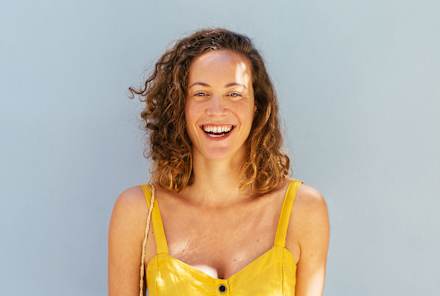Advertisement
I Did Yoga Nidra Almost Every Day For 2 Months: The Benefits I Didn't Expect


If you had asked me a year ago to define yoga nidra, I probably would have given you a blank stare and guessed something like "Is that the one where you do a lot of headstands?"
Though I've practiced yin and vinyasa yoga for years as part of my workout routine, I had zero experience with yoga nidra—a form of the practice that doesn't incorporate movement but rather involves deep relaxation through a verbal talk-down.
Several months ago, though, when a health condition cropped up that both my doctor and I suspected was stress-related, I decided to try some mind-body strategies to calm the emotional storm behind my physical issues.
Yoga nidra has given me a new vocabulary for self-compassion
A quick YouTube search yielded several videos of yoga nidra. Commenters raved that these audio sessions brought them mental peace and calmed their nervous system—the very outcomes I was seeking. It sounded pretty low-risk and as a busy working mom, I couldn't argue with the idea of squeezing in some extra relaxation, so I decided to give it a try.
For nearly two months, I carved out 20-30 minutes in my afternoon to take to my bed, close my eyes, and let the gentle voice of my new favorite yoga nidra instructor (Ally Boothroyd of Sarovara Yoga) guide me. With each session, I followed her instruction to focus on one body part at a time, bringing it peace and relaxation, usually accompanied by ambient music and guided imagery. From my first listen, I was hooked.
I can't say my yoga nidra practice has healed my physical health issue, but it has opened a door to a host of other unexpected benefits. Here are some of the surprising gifts a daily yoga nidra practice has granted me:
It's improved my sleep
Yoga nidra is also known as "yogic sleep" because of the state of consciousness it produces—a state somewhere between sleeping and waking. I'm here to say that name is legit.
Though I've never actually fallen asleep during my daytime sessions, using yoga nidra's principles of relaxing each individual body part is a godsend at bedtime. When I struggle to fall asleep, I often turn to this step-by-step, body-part-by-body-part strategy. I've never gotten through my entire body before drifting off! I'm not the only one. A large 2020 study1 found that a brief yoga nidra meditation positively influenced subjects' sleep and overall well-being.
It's given me a new way to self-soothe
As a survivor of childhood trauma, I have a tough time getting my nervous system to just chill. Fortunately, this is another area where I've seen yoga nidra bear fruit. As soon as I "get into position" to practice this form of relaxation (i.e., lying in bed with my laptop queued up to a YouTube video), I find myself letting go of tension almost immediately.
Making it a habitual practice has developed a kind of reflex in me that says, "Go ahead and relax. You are safe here."
It's heightened my senses & helped me appreciate beauty
I didn't expect yoga nidra to engage my imagination, but as it turns out, detailed imagery is a major component of the practice. Most sessions involve picturing yourself in a specific environment and then welcoming inspiring images, such as a dew-covered rose, a butterfly, or a perfect rainbow. I've found this not only introduces a shot of beauty into my everyday life; it engages my imagination in a way I don't otherwise experience regularly.
It's granted me greater positive awareness of my body
If anything, I'm aware of sensations in my body to a fault. (I don't mind admitting I'm a bit of a hypochondriac.) But yoga nidra has helped me bring awareness to my body in a more positive way.
Yoga nidra instructors encourage picturing parts of your body as "radiant with sensation" or "shining with beauty." It's been a nice change to apply this lovely imagery to my body rather than obsessing over every little twinge of pain or unusual sensation.
It's helped me develop more self-compassion
During each yoga nidra practice, you're invited to choose a "sankalpa," a short sentence that embodies your resolution for that session. Instructors sometimes suggest sankalpas, or you can choose your own. Mine have included "I am giving myself the rest I deserve," "I am allowed to care for myself," and "I am doing enough."
In this way, yoga nidra has given me a new vocabulary for self-compassion. It's a chance to meditate on the necessity of loving and caring for myself—not just other people.
The takeaway
Practicing yoga nidra hasn't "fixed" the problem I intended it to—I'm still struggling with the same physical health issue as before. But, intriguingly, it's helped me reframe my experience with greater peace and compassion. And if you ask me, that alone makes it worth continuing.

These 6 Simple Steps Will Make The Age Of Aquarius Your Best Era Yet
Perpetua Neo, DClinPsy

These 6 Simple Steps Will Make The Age Of Aquarius Your Best Era Yet
Perpetua Neo, DClinPsy

These 6 Simple Steps Will Make The Age Of Aquarius Your Best Era Yet
Perpetua Neo, DClinPsy

These 6 Simple Steps Will Make The Age Of Aquarius Your Best Era Yet
Perpetua Neo, DClinPsy









